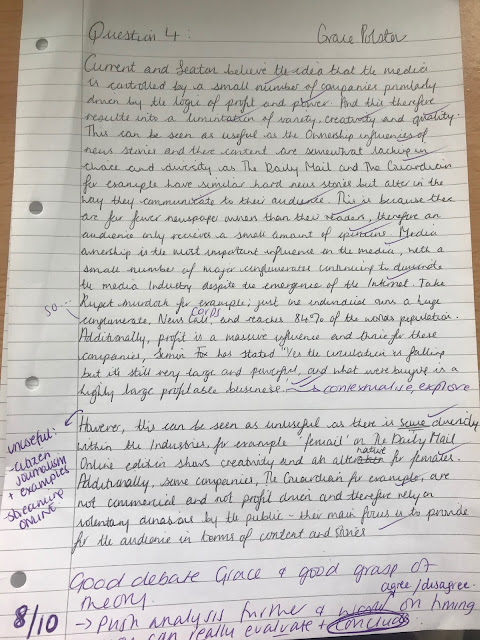DIRT Marksheet 7 – H409
Music Videos Artist representations in mv’s
Name: Grace Polston Date:
AO1: Demonstrate
knowledge and understanding of the theoretical framework of media and contexts
of media and their influence
Assessment Objectives AO1: 1a 1b – Demonstrate knowledge and
understanding of the theoretical framework of media.
AO1 Total: 10 marks.
The content below is not prescriptive and all valid points should be
credited. It is not expected that responses will include all of the points
listed.
AO1:1 How producers may choose to include different representations in
music videos to promote the artist(s), for example:
·
producers of music videos may construct representations of the artist(s) that
emphasise key aspects of their image, such as their performance prowess, which
depending on the genre of music video could be high paced, coordinated dance
routines, or performance highlighting the artist’s (or artists’) musical
prowess and artistry, or narrative performance highlighting the artist’s (or
artists’) image. Music videos may focus on one element of those highlighted
above in depth but producers are more likely to select a combination of these
elements to strongly emphasise key aspects of the artist’s (or artists’)
mediated image.
·
producers of music videos may construct representations of the target audience
for the artist(s), for example the storyline of narrative elements of a music
video may feature representations (or idealised representations) of fans (the
target audience) interacting with the artist(s) in order to elicit within fans
a feeling of belonging and loyalty with regard to the mediated image and/or
music of the artist’s (or artists’).
·
producers of music videos may promote the artist(s) to their fan-base (target
audience) through elicit value-transference to the artist(s) through
representations other than those of the artist(s), for example: o through
artistic excellence and high production values, e.g. a highly cinematic in
style narrative music video; or through more abstract, ‘high art’ expressionist
videos (that may be live action, animated or feature digital CGI; or feature a
combination of these elements) that appeal to the artist’s (or artists’)
fan-base (target audience) o through the use of glamour, for example, featuring
representations artist(s) through the use of performers (which may be real,
digital or animated) in ‘glamorous’ and / or highly aspirational situations o
music videos may also elicit value
· List
A videos using social realist representation of ‘street life’ to represent the
authenticity and cultural currency of the Corinne Bailey Rae video, aiming to
transfer that value of transcendence to the artist
· the
use of intertextual, postmodern representations in List B videos. the
cinéphiliac recreation of Spielbergian 80s suburban America in the David Guetta
video
· the
use of messages and viewpoints in videos that aim to bolster the image of the
artist and chime with those of the positioned audience - the very filmic
representation of teenage alienation in Guetta’s video creates an ambiguous
message that adds to the sophistication of Guetta’s image and fits the
large-scale nature of the song.
·
Comprehensive demonstration of knowledge and
understanding of representations in music videos.
·
Comprehensive, detailed and accurate knowledge
and understanding of representations in music videos.
·
Clear and precise and balanced explanation of
how representations are chosen to promote the artist(s) in music videos.
7–10
Answer is supported by detailed and accurate reference to one set music
video.
4–6 An adequate demonstration of knowledge and
understanding of representations in music videos.
·
Adequate and generally accurate knowledge and
understanding of representations in music videos.
· Generally accurate
explanation of how representations are chosen to promote the artist(s) in music
videos.
· Answer is supported by
general accurate reference to one set music video
1–3 A minimal demonstration of
knowledge and understanding of representations in music videos. · Knowledge of
representation in music videos is minimal, demonstrating little understanding.
· Explanation of how
representations are used in music videos is minimal and may not always be
accurate. ·
Reference to a set music video to support the answer is minimal and may be
inaccurate.
0 No response or no response worthy of
credit.
|
|
|
Identify
a strength or strengths in your assessment:
What
are the areas you need to improve?
What
do you need to focus on for your next music video assessment?
|




